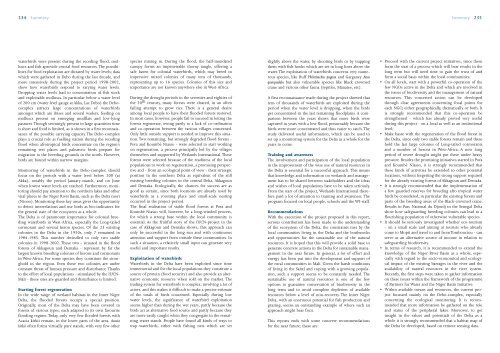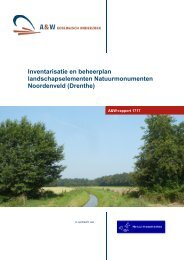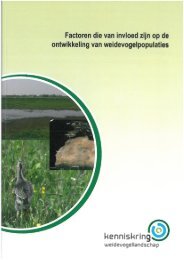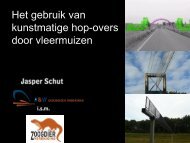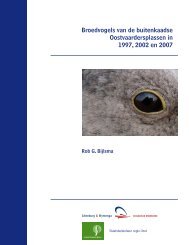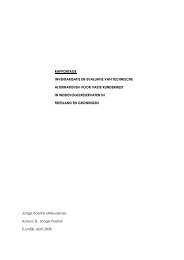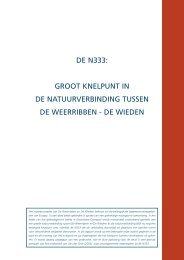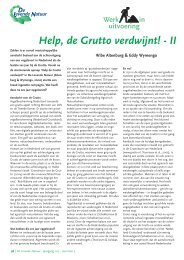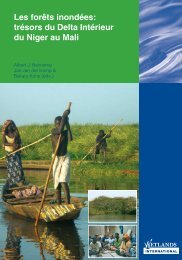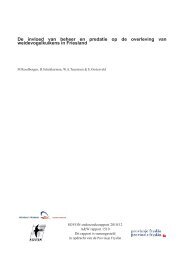Delta intérieur Du fleuve niger
Delta intérieur Du fleuve niger
Delta intérieur Du fleuve niger
You also want an ePaper? Increase the reach of your titles
YUMPU automatically turns print PDFs into web optimized ePapers that Google loves.
234 Summary<br />
waterbirds were present during the receding flood, molluscs<br />
and fish aprovide crucial food resources. The possibilities<br />
for food exploitation are dictated by water levels; data<br />
which were gathered in Debo during the last decade, and<br />
more intensively during the project period 1998-2002,<br />
show how waterbirds respond to varying water levels.<br />
Dropping water levels lead to concentration of fish stock<br />
and exploitable molluscs. In particular below a water level<br />
of 200 cm (water level gauge at Akka, Lac Debo) the Debocomplex<br />
attracts large concentrations of waterbirds<br />
amongst which are ibises and several waders, feeding on<br />
molluscs present on emerging mudflats and low-lying<br />
pastures. Though seemingly present in large quantities time<br />
is short and food is limited, as is shown in a first reconnaissance<br />
of the possible carrying capacity. The Debo-complex<br />
plays a crucial role as fuelling station during the receding<br />
flood when afrotropical birds concentrate on the region’s<br />
remaining wet places and palearctic birds prepare for<br />
migration to the breeding grounds in the north. However,<br />
birds are bound within narrow margins.<br />
Monitoring of waterbirds in the Debo-complex should<br />
focus on the periods with a water level below 200 (at<br />
Akka), notably the period January-march, and on June<br />
when lowest water levels are reached. Furthermore, monitoring<br />
should pay attention to the northern lakes and other<br />
vital places in the Niger River Basin, such as the <strong>Delta</strong> mort<br />
(Niono). Monitoring these key areas gives the opportunity<br />
to detect interrelations and use birds as bio-indicators for<br />
the general state of the ecosystem as a whole.<br />
The <strong>Delta</strong> is of paramount importance for colonial breeding<br />
waterbirds in West-Africa, especially the Long-tailed<br />
cormorant and several heron species. Of the 23 existing<br />
colonies in the <strong>Delta</strong> in the 1950s, only 7 remained in<br />
1984-1985. This number dwindled to only two stable<br />
colonies in 1998-2002. These two - situated in the flood<br />
forests of Akkagoun and Dentaka - represent by far the<br />
largest known breeding colonies of herons and cormorants<br />
in West-Africa. For some species they constitute the stronghold<br />
in the region. Even these two colonies are under<br />
constant threat of human pressure and disturbance. Thanks<br />
to the effort of local populations - stimulated by the IUCN-<br />
Mali - these sites are guarded and disturbance is limited.<br />
Starting forest regeneration<br />
In the wide range of wetland habitats in the Inner Niger<br />
<strong>Delta</strong>, the flooded forests occupy a special position.<br />
Originally, most of the <strong>Delta</strong> may have been covered in<br />
forests of various types, each adapted to its own favourite<br />
flooding regime. Today, only very few flooded forests with<br />
Acacia kirkii remain, in the lower parts of the area. Acacia<br />
kirkii often forms virtually pure stands, with very few other<br />
species mixing in. <strong>Du</strong>ring the flood, the half-inundated<br />
canopy forms an impenetrable thorny tangle, offering a<br />
safe haven for colonial waterbirds, which may breed in<br />
impressive mixed colonies of many tens of thousands,<br />
representing up to 16 species. Colonies of this size and<br />
importance are not known anywhere else in West-Africa.<br />
<strong>Du</strong>ring the drought periods in the seventies and eighties of<br />
the 20 th century, many forests were cleared, in an often<br />
failing attempt to grow rice. There is a general desire<br />
among local people to have their flooded forests restored.<br />
In most cases, however, people fail to succeed in letting the<br />
forests regenerate, owing partly to a lack of co-ordination<br />
and co-operation between the various villages concerned.<br />
Only little outside support is needed to improve this situation.<br />
Two remaining, but strongly degraded flood forests -<br />
Pora and Koumbé Niasso - were selected to start working<br />
on regeneration, a process principally led by the villages<br />
themselves and supported by Wetlands International. These<br />
forests were selected because of the readiness of the local<br />
populations to work on regeneration, a promising perspective<br />
and - from an ecological point of view - their strategic<br />
position in the southern <strong>Delta</strong> as equivalent of the still<br />
existing breeding colonies in the central <strong>Delta</strong>, Akkagoun<br />
and Dentaka. Ecologically, the chances for success are as<br />
good as certain, since both locations are already used by<br />
waterbirds as a roosting place and small-scale nesting<br />
occurred in the project-period.<br />
The final realisation of stable flood forests at Pora and<br />
Koumbé Niasso will, however, be a long-winded process,<br />
for which a strong base within the local community is<br />
essential. As the fruitful story of the IUCN-project in the<br />
case of Akkagoun and Dentaka shows, this approach can<br />
only be successful in the long run and with continuous<br />
attention and support from outside these communities. In<br />
such a situation, a relatively small input can generate very<br />
useful and important results.<br />
Exploitation of waterbirds<br />
Waterbirds in the <strong>Delta</strong> have been exploited since time<br />
immemorial and for the local populations they constitute a<br />
source of protein (food security) and also provide an alternative<br />
economic resource when sold on the market. The<br />
trading system for waterbirds is complex, involving a lot of<br />
actors, and this makes it difficult to make a precise estimate<br />
of the totals of birds concerned. Especially during low<br />
water levels, the significance of waterbird exploitation<br />
seems higher than during the wet years, partly because the<br />
birds act as alternative food source and partly because they<br />
are more easily caught when they congregate in the remaining<br />
water stands. People have found all kinds of ways to<br />
trap waterbirds, either with fishing nets which are set<br />
slightly above the water, by shooting birds or by trapping<br />
them with fish hooks which are set in long lines above the<br />
water. The exploitation of waterbirds concerns very numerous<br />
species, like Ruff Philomachus pugnax and Garganey Anas<br />
querquedula but also vulnerable species like Black crowned<br />
crane and various other fauna (reptiles, Manatee, etc).<br />
A first reconnaissance made during the project showed that<br />
tens of thousands of waterbirds are exploited during the<br />
period when the water level is dropping, when the birds<br />
get concentrated in the last remaining floodplains. A comparison<br />
between the years shows that more birds were<br />
captured in years with a low flood, presumably because the<br />
birds were more concentrated and thus easier to catch. The<br />
study delivered useful information, which can be used to<br />
set up a monitoring system for the <strong>Delta</strong> as a whole for the<br />
years to come.<br />
Training and awareness<br />
The involvement and participation of the local population<br />
in the improvement of the wise use of natural resources in<br />
the <strong>Delta</strong> is essential for a successful approach. This means<br />
that knowledge and information on wetlands and management<br />
has to be shared between stakeholders and the ideas<br />
and wishes of local populations have to be taken seriously.<br />
From the start of the project, Wetlands International therefore<br />
paid a lot of attention to training and awareness. The<br />
program focused on local people, schools and the WI-staff.<br />
Recommendations<br />
With the execution of the project proposed in this report,<br />
serious contribution has been made to the understanding<br />
of the ecosystem of the <strong>Delta</strong>, the constraints met by the<br />
local communities living in the <strong>Delta</strong> and the bottlenecks<br />
and opportunities for the sustainable use of the natural<br />
resources. It is hoped that this will provide a solid base to<br />
generate concrete actions in the <strong>Delta</strong> for sustainable management<br />
in the near future. In general, a lot of effort and<br />
energy has been put into the development and support of<br />
the rural communities in Mali. Given the harsh conditions<br />
of living in the Sahel and coping with a growing population,<br />
such a support seems to be constantly needed. The<br />
sustainable use of natural resources is one of the few<br />
options to guarantee conservation of biodiversity in the<br />
long term and to avoid complete depletion of available<br />
resources below a level of non-recovery. The Inner Niger<br />
<strong>Delta</strong>, with an enormous potential for fish production and<br />
grazing, seems an outstanding example of where such an<br />
approach might bear fruit.<br />
This reports ends with some concrete recommendations<br />
for the near future; these are:<br />
Summary 235<br />
• Proceed with the current project initiatives, since these<br />
form the start of a process which will bear results in the<br />
long term but will need time to gain the trust of and<br />
form a social basis within the local communities;<br />
• On all levels, start with a powerful co-operation of the<br />
few NGOs active in the <strong>Delta</strong> and which are involved in<br />
the issues of biodiversity and the management of natural<br />
resources. This concerted action can be developed<br />
through clear agreements concerning focal points for<br />
each NGO, either geographically, thematically or both. It<br />
is strongly recommended that this co-operation be<br />
strengthened - which has already proved very useful<br />
during this project - on a local as well as an institutional<br />
level;<br />
• Make haste with the regeneration of the flood forest in<br />
the <strong>Delta</strong>, since only two stable forests remain and these<br />
hold the last large colonies of Long-tailed cormorants<br />
and a number of herons in West-Africa. A new long<br />
period of severe drought might put these under heavy<br />
pressure. Besides the promising initiatives started in Pora<br />
and Koumbé Niasso, it is strongly recommended that<br />
these kinds of activities be extended to other potential<br />
locations, without forgetting the strong support required<br />
for the already existing forests of Akkagoun and Dentaka.<br />
• It is strongly recommended that the implementation of<br />
a few guarded reserves for breeding afro tropical water<br />
birds be considered, in particular the existing forests and<br />
parts of the breeding areas of the Black-crowned crane.<br />
Results in Parc National du Djoudj in the Senegal <strong>Delta</strong><br />
show how safeguarding breeding colonies can lead to a<br />
flourishing population of otherwise vulnerable species.<br />
• It should be seriously investigated whether eco-tourism<br />
- on a small scale and aiming at tourists who already<br />
come to Mopti and travel to and from Tombouctou - can<br />
serve as an alternative source of income in relation to<br />
safeguarding biodiversity.<br />
• In terms of research, it is recommended to extend the<br />
knowledge of the Niger River Basin as a whole, especially<br />
with regard to the socio-economical and ecological<br />
impact of the existing barrages in the river and the<br />
availability of natural resources in the river system.<br />
Recently, the first steps were taken to gather information<br />
on these issues within the framework of the programme<br />
of Partners for Water and the Niger Basin Initiative.<br />
• Within available means and resources, the current project<br />
focussed mainly on the Debo-complex, especially<br />
concerning the ecological monitoring. It is recommended<br />
that more information be gathered on the role<br />
and status of the peripheral lakes. Moreover, to get<br />
insight in the values and potentials of the <strong>Delta</strong> as a<br />
whole it is strongly recommended that a habitat map of<br />
the <strong>Delta</strong> be developed, based on remote sensing data.


